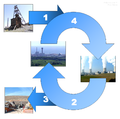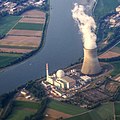Portal:Energy
| Main page | New articles & Tasks |
 The Energy Portal Welcome to Wikipedia's Energy portal, your gateway to energy. This portal is aimed at giving you access to all energy related topics in all of its forms.
|
Page contents: Selected article • Selected image • Selected biography • Did you know? • General images • Quotations • Related portals • Wikiprojects • Major topics • Categories • Help • Associated Wikimedia |
Introduction
Energy (from Ancient Greek ἐνέργεια (enérgeia) 'activity') is the quantitative property that is transferred to a body or to a physical system, recognizable in the performance of work and in the form of heat and light. Energy is a conserved quantity—the law of conservation of energy states that energy can be converted in form, but not created or destroyed. The unit of measurement for energy in the International System of Units (SI) is the joule (J).
Forms of energy include the kinetic energy of a moving object, the potential energy stored by an object (for instance due to its position in a field), the elastic energy stored in a solid object, chemical energy associated with chemical reactions, the radiant energy carried by electromagnetic radiation, the internal energy contained within a thermodynamic system, and rest energy associated with an object's rest mass. These are not mutually exclusive.
All living organisms constantly take in and release energy. The Earth's climate and ecosystems processes are driven primarily by radiant energy from the sun. The energy industry provides the energy required for human civilization to function, which it obtains from energy resources such as fossil fuels, nuclear fuel, and renewable energy. (Full article...)
Selected article
Solar photovoltaics is growing rapidly, albeit from a small base, to a total global capacity of 40,000 MW at the end of 2010. More than 100 countries use solar PV. Installations may be ground-mounted (and sometimes integrated with farming and grazing) or built into the roof or walls of a building (building-integrated photovoltaics).
Driven by advances in technology and increases in manufacturing scale and sophistication, the cost of photovoltaics has declined steadily since the first solar cells were manufactured. Net metering and financial incentives, such as preferential feed-in tariffs for solar-generated electricity, have supported solar PV installations in many countries.
Selected image

Photo credit: Postdlf
Lightning is a highly visible form of energy transfer.
Did you know?

- Buildings constructed to the German Passivhaus standard use 75% to 95% less energy for space heating and cooling than current new buildings in the United States?
- Crossing 4,000 km (2,500 miles), the Druzhba pipeline is the world's longest oil pipeline?
- Coal is ground to a powder before being burnt in fossil fuel power plants?
- Compact fluorescent lamps (pictured) use about 1/4 of the energy of normal incandescent light bulbs, and pay for themselves after about 500 hours of use?
- Nuclear power in France produces 78% of all the country's electricity - more than in any other nation?
- Positive lightning bolts are typically six to ten times more powerful than normal lightning — and aircraft are not designed to withstand them?
- Dark energy is a hypothetical form of energy which permeates all of space?
Selected biography
Rockefeller founded the Standard Oil Company in 1870 and ran it until he retired in the late 1890s. He continued to retain his stock and his title as president until 1911, when the company was broken up for carrying out illegal monopoly practices. The new companies formed included the predecessors of Conoco, Amoco, Chevron, Esso, Mobil and Sohio. Rockefeller, who had rarely sold shares, owned stock in all of them. As gasoline had grown in importance his wealth had soared and he became the world's richest man and the first billionaire.
Rockefeller's fortune was used to create the modern systematic approach of targeted philanthropy with foundations that had a major impact on medicine, education, and scientific research. His foundations pioneered the development of medical research, and was instrumental in the eradication of hookworm and yellow fever. At his death, at the age of 98, Rockefeller's remaining fortune was estimated at $1.4 billion. As a percentage of the United States economy, no other American fortune has ever come close.
In the news
- 30 November 2024 – Ibar-Lepenac attack
- Police arrest eight people linked to an explosion on a canal near Zubin Potok, Mitrovica District, Kosovo, that supplies water to the country's two main power plants. The Kosovar government blames Serbia for the "terrorist" acts, which Serbia denies. (Al Jazeera) (Euronews) (Le Monde)
- 28 November 2024 – Russian invasion of Ukraine
- Russian strikes against Ukrainian infrastructure, Ukrainian energy crisis
- 22 November 2024 –
- Energy company Phillips 66 is indicted in a United States federal court on six charges of violating the Clean Water Act in Los Angeles County, California. (CBS News)
- 20 November 2024 –
- Indian billionaire and Adani Group chairman Gautam Adani is indicted in the U.S. for his role in an alleged multi-billion dollar bribery and fraud scheme where he and seven others paid Indian government officials US$265 million to obtain contracts for Adani Green Energy. (AsiaOne) (Bloomberg)
- 18 November 2024 – Russian invasion of Ukraine
- Ukrainian energy crisis, 17 November 2024 Russian strikes on Ukraine
General images
Quotations
- "There are only two ways to stabilize concentration of greenhouse gases. One is to avoid emitting them in the first place; the other is to try to capture them after they're created. And there are problems with both approaches." – George W. Bush, 2001
- "The planet has a fever. If your baby has a fever you go to the doctor. If the doctor says you need to intervene here, you don't say, 'Well, I read a science fiction novel that told me it's not a problem.' If the crib's on fire, you don't speculate that the baby is flame retardant. You take action." – Al Gore, 2007
- "If the climate researchers' reports are to be believed, global warming is a huge medium and long-term threat, one which could have dramatic consequences such as refugee flows and armed conflicts." – Angela Merkel, 2007
Related portals
WikiProjects
WikiProjects connected with energy:
Other WikiProjects that may be of interest:
Major topics
Major categories
National energy supply, use & conservation
National electricity sector
Politics, economics, environment
- Climate change
- Energy conservation
- Energy economics
- Energy crises
- Energy development
- Energy policy
- Peak oil
Energy sources
- Fuels
- Biofuels
- Fossil fuels
- Fusion power
- Nuclear technology
- Renewable energy
- Energy conversion
- Electric power
- Energy storage
Energy-related design
Scientific usage
Help

Puzzled by energy?
Can't answer your question?
Don't understand the answer?
- Ask at the reference desk
- Read the Wikipedia help pages
For further ideas, to leave a comment, or to learn how you can help improve and update this portal, see the talk page.
Associated Wikimedia
The following Wikimedia Foundation sister projects provide more on this subject:
-
Commons
Free media repository -
Wikibooks
Free textbooks and manuals -
Wikidata
Free knowledge base -
Wikinews
Free-content news -
Wikiquote
Collection of quotations -
Wikisource
Free-content library -
Wikiversity
Free learning tools -
Wiktionary
Dictionary and thesaurus


























































































































































































